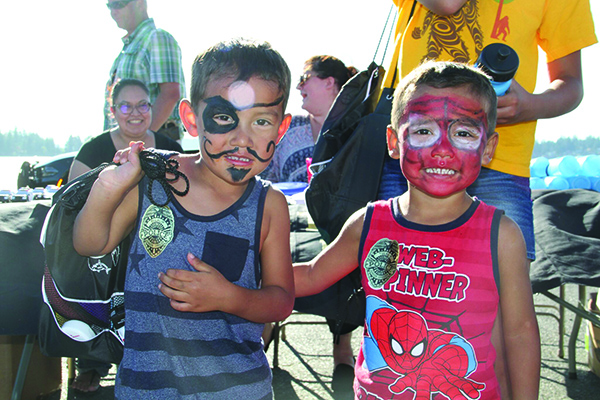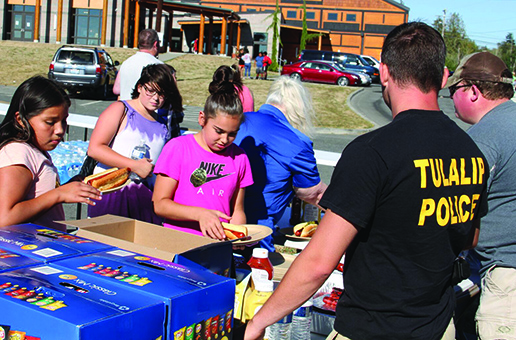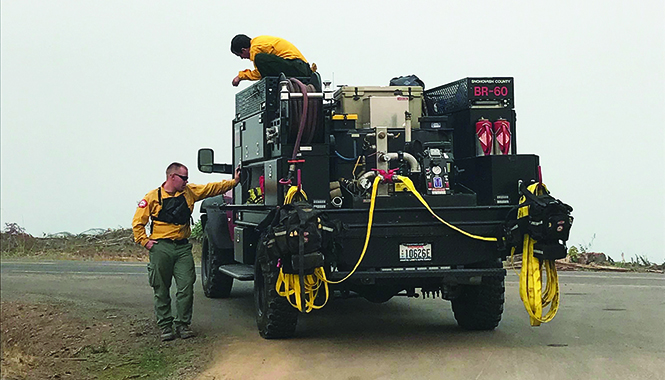
By Shaelyn Smead; photos courtesy of Natosha Gobin, John Carlson, and Lindsay Ross
All over Washington state, people have heard about the devastating Bolt Creek Fire that started on September 10 at 5:00 a.m. in Skykomish. As of September 13 at 5:15 a.m., a devastating 9,440 acres have been burned, with only a 5% containment on the fire. The fire stretches from Skykomish to Halford, and is leaving people in surrounding cities to evacuate their homes. With wildfires being so scarce in Western Washington, it is leaving plenty of Washington residents alarmed, and scared about the outcome of such a large fire.
Within the same area as the fire, there are two properties that Tulalip owns. These properties are typically called the Grotto Lake parcel and the Eagle Creek parcel. The properties were originally bought by Tulalip back in October 2019 in efforts to allow a safe and sacred area for tribal members to harvest berries, pull cedar, camp, hike, hunt, collect resources for cultural arts, and hold cultural practices. It was an enticing piece of land because of its proximity to Tulalip and its relation to our Coast Salish ancestors. Along with that, because of the drastic levels of elevations, the parcels’ vegetation grew many different variations of natural resources that tribal members could collect and utilize.
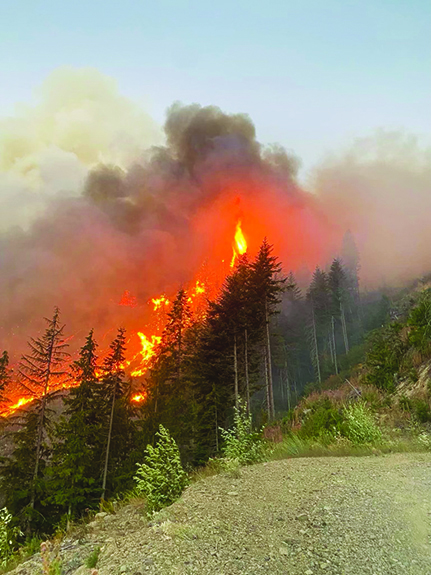
Director of Treaty Rights and Government Affairs, Ryan Miller, described the properties stretching to about 1000 acres. He said approximately 50% of each property has already succumbed to the devastation of the fire.
When news broke out about the fire, and the threat it does to our cultural practices, it left some tribal members is disarray. The thought of this land not being accessible for any sacred works anymore is heartbreaking for Tulalip and many are left wondering what will become of it.
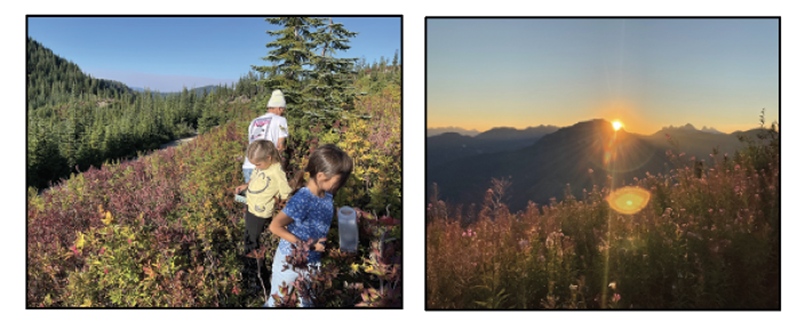
The night before the start of the fire, Tulalip Tribal member Natosha Gobin and her family just happened to be on one of the Tulalip properties harvesting berries. “We went about four or five times this year. This time around, we left the peak at 7:30 p.m. Our hopes were to get up early and head back the next morning because the berries were plentiful. We were so excited to finally be introduced to the space, it felt so healing to be up there. This fire is so heartbreaking,” Natosha said. Luckily her family had a change of plans, and did not go back up the mountain the next morning and none of her family risked any danger of the fire.
One major change that some tribal members have noticed and attested to is the abundance of trees that have grown over the years. Along with that, the road is really rough making the properties difficult to get to. Something that is later found to be a difficult realization for the firefighters involved.
The Tulalip Fire Department has been one of the many resources that has been supporting efforts towards battling wildfires in the Pacific Northwest. Currently the department has two task forces stationed out. One of which consists of three members that are located in Oregon taking on the Cedar Creek Fire, just a mere three days before the start of the Bolt Creek Fire. One of the members is John Carlson, who has been with the department for six years. Cedar Creek Fire makes for his first experience with a wildfire.

John spoke about the wildfires and how they are so different in perspective to structure fires in the Tulalip area, “With structure fires, we’re usually well-trained and know the area very well, versus on a landscape, we’re fighting the larger grassland, sagebrush, larger timber, and heavy terrain. We also mainly work off brush trucks when dealing with wildfires, and a problem we face is water supply. We do have a water tender in our strike team, but if it runs out, we have to get resourceful with our water supply. Being up in the terrain we can’t directly connect to a fire hydrant, so sometimes we find ourselves syphoning from pools, streams, lakes, etc. Anything with 100 gallons of water can make a huge difference,” he said.
When news broke out about the Bolt Creek Fire, the three-man crew had already gotten settled in with the team in Oregon. “This is the first time I’ve been deployed and there was a fire of this magnitude near our home,” John said. “A lot of us we wondering if we would get redirected back. But with the resources that we have sent up to Bolt Creek, we felt confident in the team’s ability. Much like a lot of fire departments, every summer during peak season our department gets stretched in different directions. But as much we appreciate and are glad to be helping take care of members down here, it is hard when we know our home isn’t safe.”
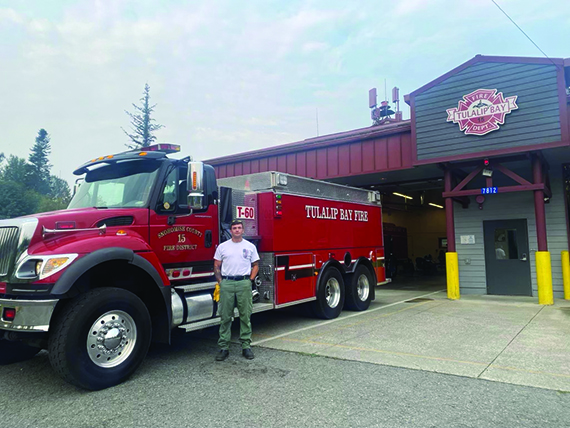
Of course with the Bolt Creek Fire being a prominent fire in our area, and the risk it brings to the Tulalip owned properties, an additional two Tulalip firefighters have been sent to Skykomish, Paramedic Lindsay Ross and firefighter Austin Panek left early this week to help Sky Valley Fire Department. Amongst them are the other 20+ fire departments and private fire companies that include North Ridge Fire, American Fire, Zigzag Hotshots, and Patrick Environmental, making up for more than 317 personnel that have opted in for fighting this fire.
Lindsay has been with the fire department for six years, but has an extensive 10-year career working as a wildland firefighter. This is her first time working as a line medic, and her role is to help work with the crews onsite to ensure their safety, help with any medical care, and help with the falling rocks in the area.
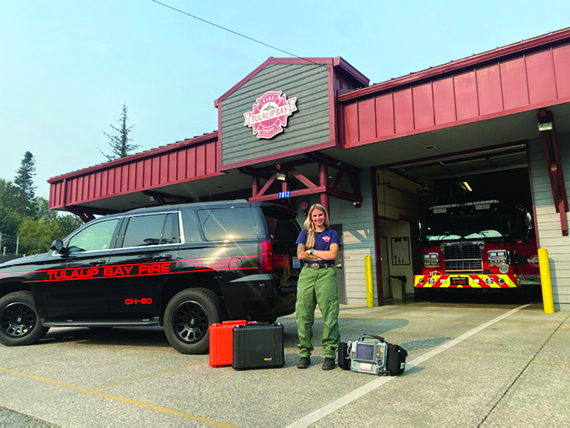
Lindsay explained that even though wildfires of this magnitude are rare in Western Washington, it is something that should be expected for the future. “When fires do take off over here, there’s usually a lot of old debris and old trees that are likely dried up and when it builds up over time, a fire is able to take off easier. There is definitely some prescribe burns that the state will do to try and thin out the forest a little so it doesn’t happen as often. But with the summers getting hotter every year and with having lower humidity, I think a fire like this in our area has been overdue for a while.”
Hearing from wildfire experts like Lindsay, we learned that even though wet and rainy springs and early summers seem like they would help decrease the risk of wildfires, that isn’t always the case.
“Rain during that time of the year does make fire danger go lower, but it also will make more sagebrush and longer grasses, that eventually will dry up in the summer and turn into fuel for the fires,” said John. “The more that grows in the spring and early summer, the heavier potential fire fuel load it creates, and the bigger the fire can get. Something we noticed this year was that we had a lot more fire fuels from Spring than I think in years’ past.”
What is most difficult about Bolt Creek Fire is the heavy terrain that exists in the area. “With the heavy forestry and it being hillside, we have a more difficult time accessing the spots that are burning hot,” said Lindsay. “And with no accessible roads in most spots, heavy equipment cannot be easily moved around.”
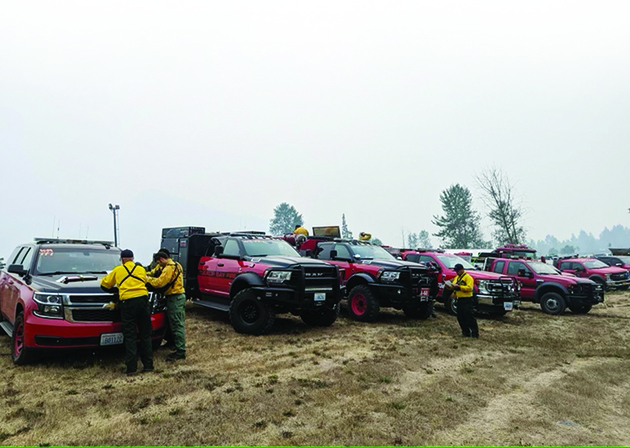
Between hot summers, lower humidity, and lots of drier vegetation and debris, another factor for this fire is the amount of wind that picked up in the area. Local fire departments refer to the ‘Witching Hour’ that falls between 2:00 p.m. and 6:00 p.m. During this time, wind begins to pick up and is at its heaviest, making this the most dangerous part of any day. Knowing that wind can be so unpredictable with how fast it goes and in which direction, can lead to a lot of variations of disaster. The Bolt Creek Fire had around 30-40 mph winds, which ultimately made for its drastic escalation.
“The reality of this fire is that its burning really close to our backyard”, said Tulalip Fire Chief Ryan Shaughnessy. “There’s people that have family and friends in the area and that we’re concerned about. But we’re working hard and wish for the best outcome by everyone.”
The Bolt Creek Fire did receive some water and fire retardant dropping from planes flying above. A typical resource used for fires in heavy terrain. Along with that, many firefighters have been working to diminish the terrain and have been putting a dirt dozer line bordering the fire in hopes to create a stopping point. Any houses around the area have also received some treatment and precautionary actions in case the fire continues to spread.

Ryan spoke about the awareness of the risk of wildfires and the new potential for them in our area, “This is our first time dealing with a westside fire, but with that being said, we did understand that there was a risk of one in our future. We preemptively have been working with other tribes, and collected burn plan ideas to help mitigate future fires. That’s why, if you went up to the properties, you’d see some of the trees had already been cut. We also applied for a Federal Emergency Management Agency (FEMA) grant of 1.3 million dollars earlier this year. This funding will help us work with partners in the Snohomish Basin and understand more of the interaction between climate change and water and it’s impacts on forestry and likeliness of fire in the basin,” he stated.
With the powerfulness of the fire, it’s easy to see that these thoughts and actions taken by Tulalip were in the right direction in understanding the risks of westside fires. “Now that the fire has happened, it’s even more of a reason for us to understand and gain a better grasp on our forestry, and the FEMA grant will help inform us for the future,” Ryan said.
Understanding fires in our area and the reality of potential for them, there are definitely steps that can be taken by citizens to help mitigate it.
“First is knowing that fires have the potential to happen anywhere,” said Lindsay. “People have to be cautious about having fires outside, lighting off fireworks, making sure you have water and mostly listening and respecting burn bans when they are in effect. People never think it’s going to happen to them until it does.”

As terrifying and devastating as wildfires can be, they do have the opportunity to act as a natural rebirthing for wildlife and vegetation. So far, Ryan has stated that there are plans for replantation in the affected area, and that they plan to work with the Forest Service and Department of Natural Resources in order to create a better plan of action, and get as much fuel load off the forest.
Along with that, he said that tribal members should expect some berry regrowth by next spring, and even though trees take a much longer time to grow to their mature state, Ryan said that we should expect tree shoots by next year. He also spoke about the hunting opportunities that the area will bring. “Deer love to eat young shoots and with the area being more open, hunters will be able to spot deer a little easier,” he said.
At the moment, the fire is still unpredictable, but firefighters are hoping to button everything up soon. The good news is that the fire doesn’t contain large flames at the moment, making the likeliness for it to spread, lower.
Thank you to the Tulalip Fire Department and all participating fire departments for your efforts.
